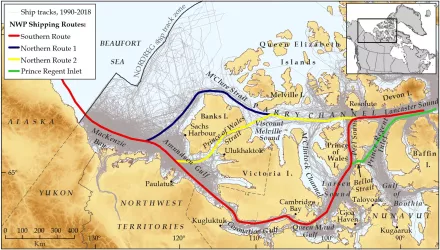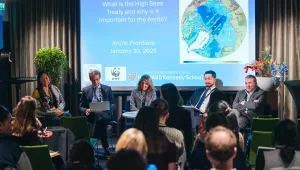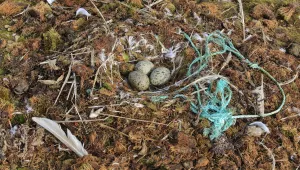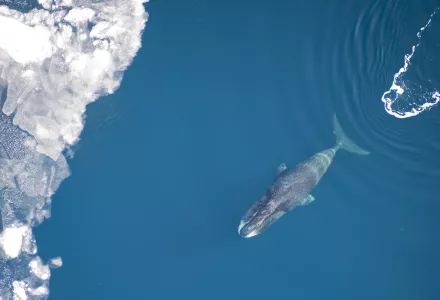
Foreword
Over the last three decades, a spirit of cooperation characterized scientific research and environmental protection efforts across the circumpolar Arctic. In particular, the Bering Strait region became an area of active cooperation between both U.S. and Russian government agencies, nongovernmental organizations (NGOs), researchers and academic institutions, Indigenous Peoples organizations, and coastal residents, who worked across geographic and institutional boundaries to understand and respond to Arctic change.
Russia’s invasion of Ukraine in 2022 abruptly forced hundreds of science and conservation initiatives to halt. Western governments, including the United States, directed employees of government agencies to curtail contact with Russian colleagues. Many universities and NGOs followed suit. Three years on, much of that work involving Russian experts and institutions has not resumed.
As the Trump administration revises the United States’ relationship with Russia, the potential for more communication between the two countries may offer an opportunity for renewed cooperation in the Bering Strait region. A review of the previous accomplishments and benefits of bilateral work may provide a foundation on which to build should tensions continue to subside.
This report summarizes key points taken from interviews with Russian and American scientists, conservation practitioners, resource managers, and representatives of Indigenous communities who have participated in joint research and conservation initiatives in the Bering Strait region. Our objective in conducting these interviews was not to comprehensively document the achievements of past transboundary cooperation in the Bering Strait region, but rather to capture the insights of some of the key individuals involved and to assess the value in restarting this work in some form, even at a time of high geopolitical tension.
The experts we spoke to expressed concern about the negative impacts of the ongoing hiatus in cooperation with Russia. Almost every interviewee shared the sense that ruptured relations with Russia will have dramatic consequences for the wellbeing of people and ecosystems in the Bering Strait region. The following pages contain their reflections on the types of programs which proved effective, the challenges they face as a result of losing key partners in science and conservation, and their suggestions and cautions for moving ahead.
Margaret Williams
Key Achievements of U.S.-Russian Cooperation on Science and Conservation in the Bering Strait Region
1. Research cooperation improved understanding of transboundary issues.
In order to manage and protect Arctic wildlife, comprehensive baseline data about populations is needed, but obtaining that data in the Bering Strait region, where it is logistically difficult to operate, can be challenging. Many Arctic species are also migratory or have large ranges that span national borders, adding to the challenge of conducting research.
U.S.-Russian research cooperation has vastly improved understanding of shared wildlife populations, including their numbers, behaviors, and responses to the changing environment. Interviewees cited the example of a research program established in the 1990s by Inupiat whalers to document the size of the Bering-Chukchi-Beaufort Sea population of bowhead whales. Without information from the Russian side of the whales’ range, uncertainty remained concerning the whales’ behaviors, distribution, and migration patterns. To address these gaps, Chukchi whalers, supported by the Department of Wildlife Management of Alaska’s North Slope Borough, joined their Inupiat colleagues in Utqiagvik (Barrow), Alaska, and combined their observations into a joint report.
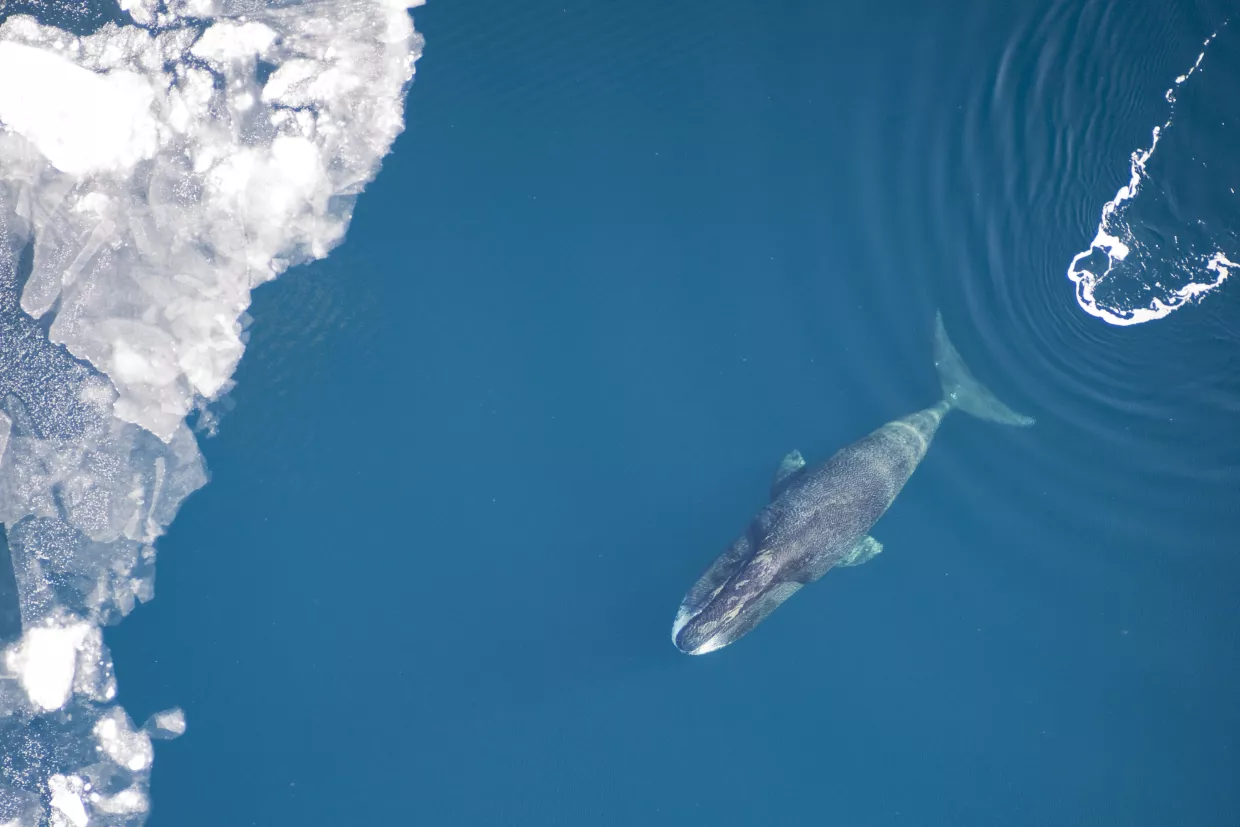
Through bilateral research programs, U.S. and Russian scientists developed shared research protocols, standardizing data collection that allowed for comparison of results between regions and over time. The harmonization of data collection and reporting extended beyond the United States and Russia to the other Arctic states and enabled international assessments such as the Arctic Council’s State of the Arctic Marine Biodiversity Report, a milestone in monitoring circumpolar marine biodiversity.
“[Before the 1990s], across nations, there were many different tools and metrics used to measure productivity and population estimates.” - American ornithologist
2. Research cooperation improved the efficiency of research processes.
Pooling resources and skills can make conducting research easier in the vast, remote natural areas of the Bering Strait Region. For example, one American ornithologist partially credited the success of a study of Arctic shorebird populations to the skill of his Russian partners in locating the birds’ nesting sites. Migratory Great Knots, Red Knots, and Surfbirds nest in low densities in upland and montane ecosystems and are thus difficult to find. Without the Russian ornithologists, obtaining results “would have taken double the time.”
“Russian ornithologists are really skilled naturalists. Bringing in such people…cut years off the effort [to survey population health of shorebirds].” - American ornithologist
Sharing equipment is another benefit of bilateral research programs. Per one Russian ornithologist, the distribution of satellite tags to Russian researchers through a joint U.S.-Russian research project enabled them to obtain “first-ever data on bird migrations” for certain areas of the Bering Sea.
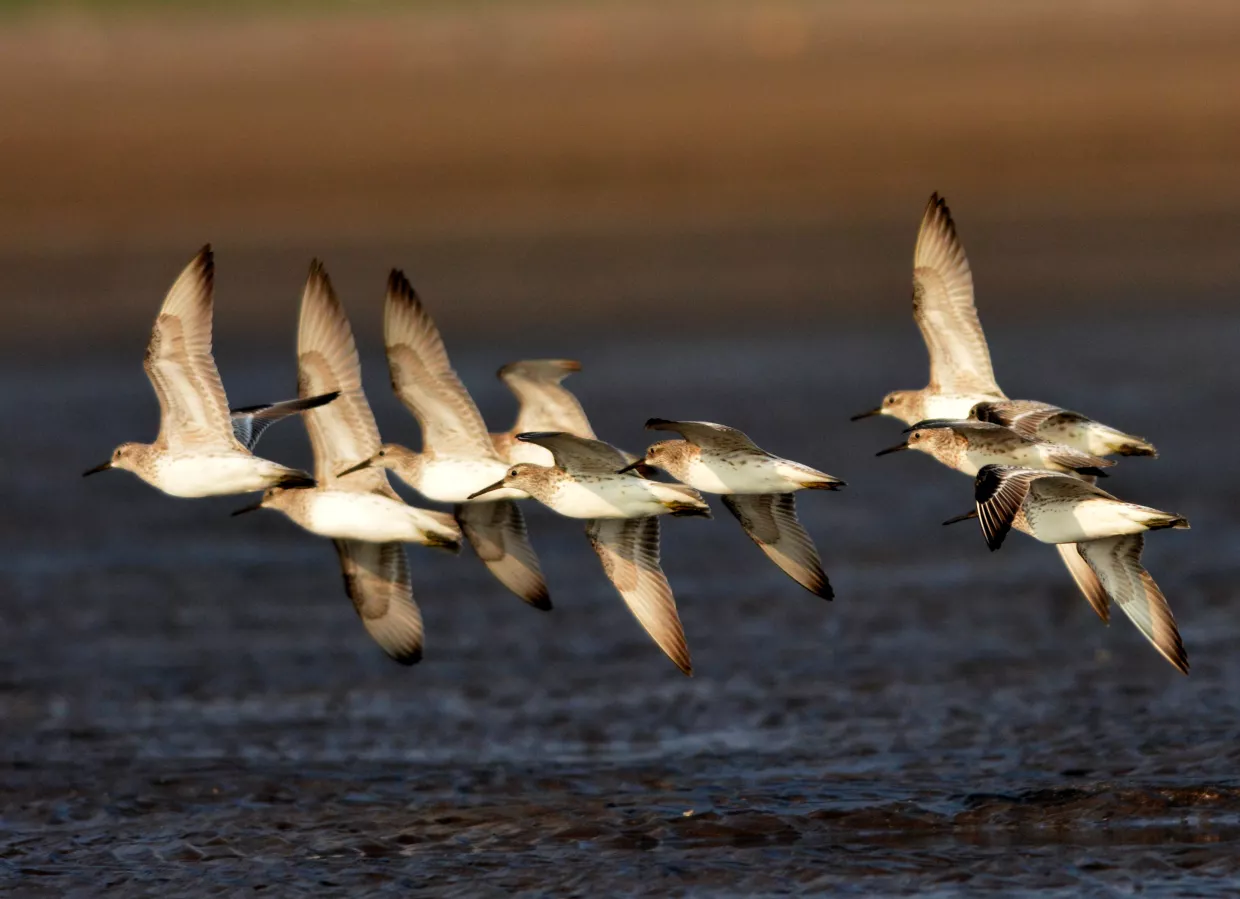
Bilateral research programs have produced innovative methods for studying wildlife in hard-to-reach areas of the Bering Strait Region. From the 1990s into the 2010s, U.S. agencies worked with Russian biologists, Inupiat hunters, and Chukchi hunters to collect observations of and attach radio tags to Pacific walruses. In the 2000s, the United States and Russia conducted aerial surveys using thermal sensors to document numbers and distributions of both Pacific walruses and polar bears. The information gathered through these research efforts advanced knowledge of both species’ regional distributions and movements, and by extension, where and how they may be affected by sea ice loss and industrial activities.
“We cannot effectively study and conserve our common populations of marine mammals without cooperating with American colleagues and indigenous people of Chukotka and Alaska, who have a lifelong connection with local nature and [those marine mammals].” – Russian biologist
3. Exchanges between U.S. and Russian scientists and conservationists led to increased habitat conservation and better outcomes for wildlife.
Transboundary cooperation between U.S. and Russian biologists accelerated habitat conservation in a variety of landscape types. When travel restrictions loosened after the fall of the Soviet Union, Russian scientists and resource managers visited the United States and observed how poor land management and overharvesting had decimated wild salmon populations, while U.S. observers in the Russian Far East gained an appreciation for the the unfragmented condition of Russia’s wild river systems. This exchange led to a twenty-year initiative to map salmon rivers, culminating in the first status assessment of salmon in the North Pacific and the protection of 6.4 million acres of land around salmon rivers in the Russian Far East alone. Cooperation was bolstered by Western donors - both government agencies and private charities - and contributed to the development of environment-focused donor networks within Russia.
U.S. and Russian cooperation led to the adoption of international market standards and best management practices. Per one interviewee, in response to rampant salmon roe poaching in the Russian Far East in the 1990s, U.S. and Russian NGOs worked together to popularize the concept of environmental certification of fisheries through the globally recognized Marine Stewardship Council, arranging site visits to Alaska and providing technical support to Russian fishing companies. Today, about 70% of salmon fisheries in the Kamchatka region are MSC-certified.
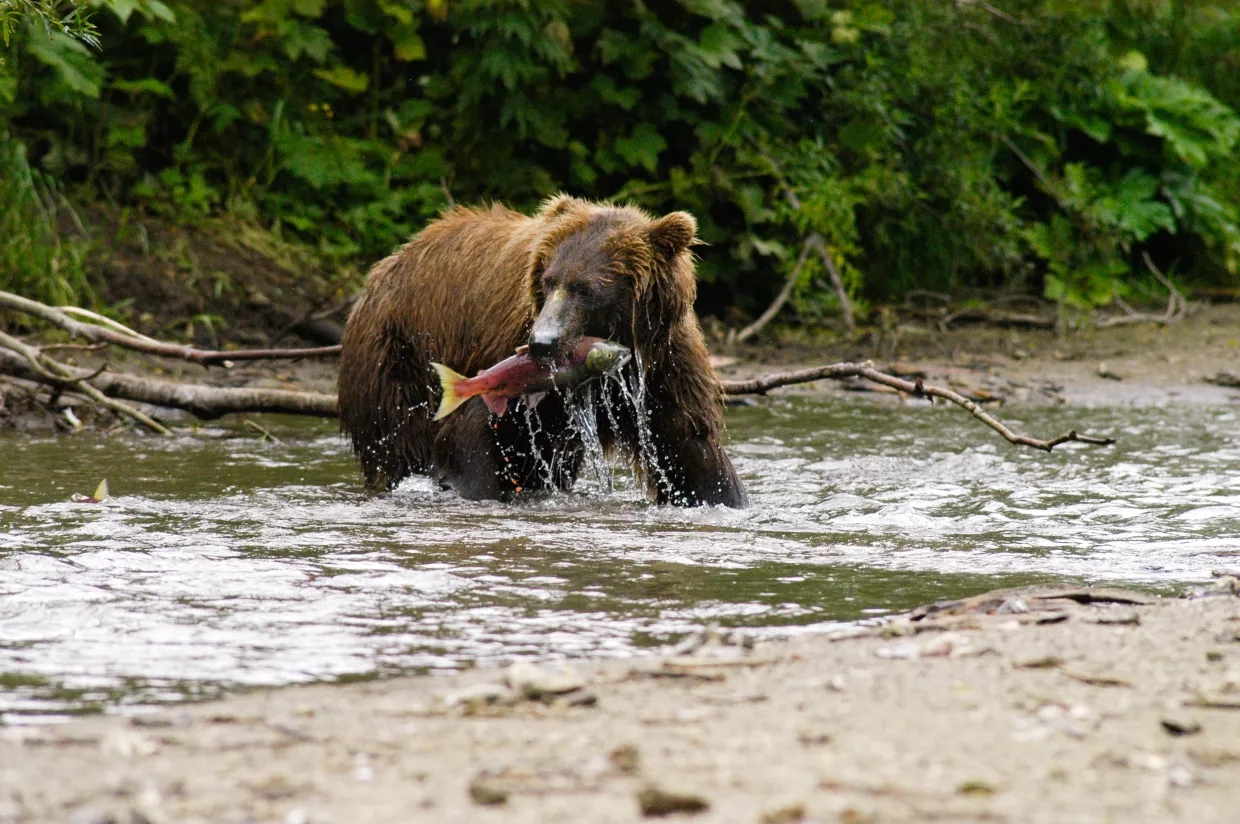
Another interviewee, a Russian fisheries expert, pointed to the adoption of seabird bycatch prevention measures by the Russian fishing industry. After Alaskan longline fishermen successfully reduced seabird bycatch by using streamer deterrents on their fishing gear, U.S. and Russian researchers quantified the costs of seabird bycatch for the Russian fishing fleet in the western Bering Sea, while a coalition of other partners - the Pacific Institute of Geography in Kamchatka, the U.S. Fish and Wildlife Service, the National Oceanic and Atmospheric Association (NOAA), and the U.S. Consulate in Vladivostok - collaborated to transfer streamers from Alaska to Kamchatka. Convinced of the economic benefits of seabird bycatch reduction, the Russian fishing sector eventually began to manufacture their own streamers.
In the 1990s, local activists in Sakhalin, concerned about the impacts of Russia’s budding offshore oil development, coordinated advocacy campaigns with U.S. NGOs to persuade the International Monetary Fund, the European Reconstruction and Development Bank, and the World Bank to require proper disposal of drilling wastes as a condition of investment in Russian oil corporations. The Sakhalin standard - to reinject drilling wastes into the seafloor rather than dumping into the marine ecosystem - became a national regulation which is still upheld today.
Exchanges of experts strengthened capacity for conservation on both sides of the strait. Per one interviewee, under the auspices of the 1974 bilateral Agreement On Cooperation in the Field of Protection of the Environment and Natural Resources (“U.S.-Russian Environmental Agreement”), dozens of scientists, educators, and managers conducted site international site visits to protected areas in both the United States and Alaska. These site visits directly led to the “sister refuge” partnership between the Alaska Maritime National Wildlife Refuge and the Commander Islands Zapovednik (“Nature Reserve”), which later spawned joint programs on invasive species prevention, seabird monitoring, and biological data sharing. Exchanges under the U.S.-Russian Environmental Agreement also heavily emphasized youth education, inspiring the establishment of environmental education departments in Russia’s national nature reserve system across the entire country, and regional or local initiatives such as the Seabird Youth Network for students from Russia’s Commander Islands and Alaska’s Pribilof Islands.
Status and Impacts of the Hiatus in U.S.-Russian Cooperation
| 2020-2022 | COVID-19 travel bans weaken long-standing U.S.-Russian partnerships on science and conservation. |
|---|---|
| February 24, 2022 | Russia invades Ukraine. |
| March 3, 2022 | Seven Arctic Council founding states - Canada, Finland, Iceland, the Kingdom of Denmark, Norway, Sweden, and the United States - announce a pause in their participation in the Arctic Council, which Russia is chairing. |
| June 11, 2022 | The Biden administration directs U.S. government and government-affiliated organizations to wind down relationships and research collaborations with institutions and individuals affiliated with the Russian government. |
| May 11, 2023 | Norway assumes the chairship of the Arctic Council, vowing to restore the Council’s full scope of work and ensure its central leadership role in the region. |
| February 28, 2024 | The Arctic Council resumes Working Group meetings in a virtual format to allow project-level work to advance. |
| 2025 | Russian researchers remain excluded from international research fora. No forum for direct U.S.-Russian government contact has resumed. |
1. Knowledge Gaps
A key area of bilateral work between Russia and Alaska has been assessing the impacts of rising Arctic air temperatures on permafrost, the layer of frozen soils which stretches across much of the circumpolar. Russia encompasses most of the permafrost-covered soils in the Arctic. The wartime prohibition on communication meant that U.S. scientists stopped sending equipment to Siberia, and Russian scientists could no longer send data to their Western partners. One Russian permafrost scientist noted that in his field, an interruption in shared data collection and analysis can be tolerated for a short while because anticipated changes in Siberia can be inferred by research in Scandinavia and Alaska. However, the scientist said that, in the long term, the loss of information coming from Russia will cause “estimates of changes in global permafrost [to be] biased.”
2. Decline in Trust
Russian and American interviewees alike spoke about the value of both personal and professional relationships with their respective international colleagues. They recounted how developing research questions jointly, then working together, often for multiple years in a row, built strong foundations of trust and respect for the other “side.” These bonds helped many cooperative projects flourish over three decades. This core element of successful bilateral work, however, is now in jeopardy, as two years of little to no in-person fieldwork (during the pandemic), followed by three years of virtually no communication, have eliminated the opportunities for Russian and American experts to meet, share ideas, conduct fieldwork, and nurture their working relationships.
Two other factors may be expected to dilute the trust that developed between American and Russian biologists and experts over the past 30 years. First, anti-American propaganda has become deeply entrenched in Russian society, particularly in the media, since Russia invaded Ukraine. Second, the Trump administration is hollowing out federal natural resource management agencies and scientific organizations, further decreasing the likelihood that people once actively involved in bilateral projects will be able to reignite their relationships.
“There are few people, if any, left in the government who were involved in the formation and implementation of the [U.S.-Russian Agreement on the Conservation and Management of the Alaska-Chukotka Polar Bear Population]. So it’s a real concern that as the years pass, the will to resuscitate this agreement will wane and all of the work that went into this treaty will be reversed.” - American biologist
Conclusion & Recommendations
A lot was accomplished to understand, protect conserve the shared environment when scientists and indigenous hunters/observers worked together and the borders were porous. Today, climate change and industrial activities are transforming the Bering Strait region. To understand, manage, and adapt to those changes, it is essential to have a picture of what is happening on both sides of the strait. As the United States’ relationship with Russia takes a new turn, there may be opportunities to renew some forms of communication and cooperation at the working level.
Recommendations for researchers and research institutions:
- Consider opportunities for U.S. and Russian researchers to plan research, share equipment, and exchange data on topics of common concern (e.g. permafrost thaw, wildfires, fish stocks).
- Invest in technologies for remote wildlife science (e.g. satellite transmitters, geolocators, acoustic buoys).
- Increase use of virtual platforms where U.S. and Russian researchers can store and access data.
- Engage with and seek the support of Russian researchers based in the United States to re-establish connections with researchers based in Russia.
-
Offer fellowships, travel grants, and conference stipends to young Russian researchers.
Recommendations for government officials:
- Revive cooperation between the U.S. Coast Guard and the Russian Marine Rescue Service through the U.S.-Russia Joint Contingency Plan.
- Invest in enhanced maritime infrastructure for vessel traffic monitoring, oil spill response, emergency response, and real-time communications about potential hazards, wildlife migrations, and subsistence activities.
- Revitalize bilateral programs such as the “sister refuge” partnership between the Commander Islands Nature Reserve and the Alaska Maritime National Wildlife Refuge.
- Consider opportunities to develop Arctic-specific cooperation through the U.S.-Russia Environmental Agreement.
- Engage in and support the working-level activities of the Arctic Council.
Williams, Margaret. “U.S.-Russian Cooperation on Science and Conservation in the Bering Strait Region: Past Achievements and Current Status.” Belfer Center for Science and International Affairs, June 17, 2025



